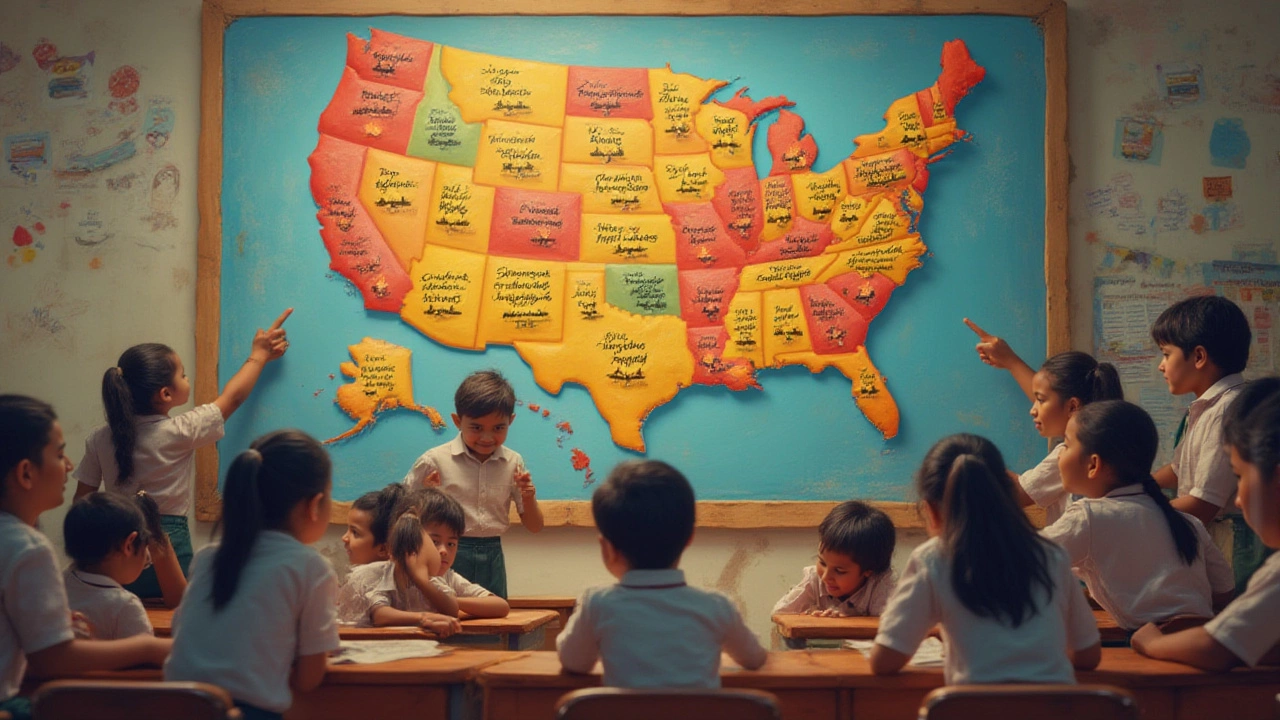If you grew up in the US or know someone who did, you’ve probably heard stories about teachers drilling practice tests, stressed-out kids filling in scantrons, and parents biting their nails while waiting for results. But here’s the twist: not all state tests are created equal. Some states hand out tricky questions that stump even the best students, while others lean toward easier, more straightforward exams. So, when people ask, “Which state has the hardest tests?”—nobody wants to give a simple answer. Because, honestly, it’s complicated.
The Battle of the Tests: How States Build Theirs
Every US state gets to make its own rules about school testing. Sure, there’s some federal guidance, especially under acts like No Child Left Behind (in the 2000s) and the Every Student Succeeds Act (ESSA), but the real details—questions, topics, and how tough the grading gets—are up to state education boards and policymakers. Back in 2025, the debate is still raging: Who’s making kids sweat, and who’s letting them off easy?
Test writers dig deep into what matters most in their region. In Texas, math and reading are everything, while Massachusetts is famous for pushing writing and critical thinking. Alaska throws in tough science questions, and California’s test designers toss in brainteasers from every subject. Each state reviews its standards, consults educators (and sometimes politicians with strong opinions), then updates the blueprint every few years.
States can either purchase big national exams, build their own, or mix and match. The smarter states test early and often—catching problems before students fall behind. Others cram the hardest tests into just a few critical years, piling on the pressure for everyone involved. What's wild is that despite millions of dollars spent on testing, there’s still no official national ranking for hardest state test. Sound unfair? Maybe. But that doesn’t stop parents, students, and even teachers from trying to figure it out.
One quirky fact: Mississippi used to set the national bar for failure before a major overhaul in 2018—a quarter of students couldn’t pass the state-wide reading test. In 2024, things looked a whole lot different: Massachusetts, New York, New Jersey, and Maryland were topping the “most challenging” lists, while states like Idaho and Wyoming kept things much more manageable.
The difference boils down mostly to two things: what’s on the test, and how you measure “passing.” Some states demand more complex answers, while others count a simple multiple-choice sheet as proof of skills. Pop quiz: Would you rather write three essays or answer a hundred quick-fire questions? Each state has its favorite way.
How Hard Is Hard? Comparing Test Scores and Standards by State
Now, you might be wondering how we actually compare which state test is harder. Do we judge by the lowest average scores? By how many students pass? Or maybe by how panicked parents sound on social media every May? Joking aside, testing experts usually look at three main things: test content, cut scores, and student performance data.
Cut scores—the number of right answers needed to pass—shift wildly between states. For example, New York’s Regents Exams (some of the oldest standardized tests in America, dating back over a century) routinely ask students to solve multi-step algebra puzzles before they can get their high school diploma. In contrast, states like Louisiana have notoriously low cut scores, meaning more students pass, but they might not have faced the trickiest problems. A jaw-dropping stat: In 2023, Louisiana’s English Language Arts assessment required just 33% correct answers to “approach basic” proficiency, while Massachusetts demanded much higher marks for a passing grade.
Check out this breakdown of recent performance and proficiency ratings. Yes, it’s a bit nerdy, but seriously useful:
| State | Required Passing Score (%) | Math Proficiency (2024, Grade 8) | ELA Proficiency (2024, Grade 8) |
|---|---|---|---|
| Massachusetts | 65-70 | 52% | 55% |
| New York | 60 | 43% | 48% |
| New Jersey | 63 | 46% | 50% |
| Texas | 45 | 35% | 38% |
| Louisiana | 33 | 22% | 24% |
Notice anything? The hardest state tests tend to require the highest passing percentages and end up with more students struggling to hit those marks. Massachusetts, for instance, expects much more to get a “proficient” rating, and it shows in the number of high-performing students—but also in complaints from tired teens who just want a break.
Another thing to throw into the mix: what’s actually on the test. In Maryland, you’ll find performance-based questions that make students show their work, not just guess. California sprinkles in cross-curricular thinking, so a social studies test might drop in questions about science or math. That brings out different skills—and can trip up kids who expected one thing and got another.

Life on the Front Lines: Teachers’ and Students’ Real Stories
Numbers can tell you a lot, but nothing beats hearing it from those who actually slog through these tests. Teachers in New York talk about weeks of lost instructional time, just prepping for the Regents Exams. One English teacher in Brooklyn joked that she spends spring basically living in her classroom: “Coffee, highlighters, and nightmares about essay prompts.”
Students? Some ace it, but for others, it’s all about beating the curve. A high school junior named Carla from Massachusetts described her prep for the MCAS (Massachusetts Comprehensive Assessment System): “You can do everything right and they’ll still throw a question at you that’s never been on any study guide.” Her friends in Texas, meanwhile, say their state’s STAAR test (State of Texas Assessments of Academic Readiness) feels like a marathon instead of a sprint. Lots of fast-paced, shorter questions, but endless reading passages and not much time to catch your breath.
Private tutors have started popping up all over states with tougher tests. In Maryland, one popular tutoring center offers “MCAP bootcamps” before state exams—charging up to $150 a session for practice runs on custom-built questions. Even teachers admit the separate language on these tests sometimes trips up non-native English speakers, or kids with learning differences.
The growing pressure has led to some surprising advocacy. In 2023, student groups in California helped push for changes in the way tests measure progress. Their feedback? More creative, project-based testing, less reliance on four-choice multiple-choice. That change is still rolling out, but it’s already making waves with districts trying to balance tough standards and student wellness.
Oh, and if you’re curious: cheating scandals do happen, but they’re pretty rare thanks to strict test security and digital proctoring systems. In 2021, Georgia had several schools flagged for suspiciously rapid answer changes. By 2025, most states use software that catches weird patterns within minutes. So, the hardest test might actually be just staying focused and playing by the rules.
Expert Tips for Surviving Tough State Tests
Worried about your own kids facing these challenges, or just want to know how to prep for high-stakes exams? The best advice comes from students and educators who’ve been through it themselves. Here are some smart, practical tips that can make a difference, whether you’re tackling New York’s algebra monster or California’s trickiest multi-subject puzzles.
- Get to know the format: Download sample tests from your state’s department of education. Practicing on the authentic layout can calm nerves—and cut down on silly mistakes from not reading instructions clearly.
- Brush up on the basics: States with hard tests (Massachusetts, New Jersey) expect kids to show mastery of both simple and advanced skills. So, don’t overlook basic math, grammar, or science facts in your rush to memorize tougher material.
- Time management is your friend: Find out what sections are timed and practice with a stopwatch. Many students get stuck on one tricky problem and lose easy points by running out of time elsewhere.
- Ask for accommodations if you need them: Students with learning differences can often get extra time or other supports if they apply early. Teachers and counselors know the rules—use their expertise.
- Make peace with stress: Even the most gifted students freak out now and then. Sharing worries with friends, keeping a steady routine, and remembering that one test score does not define your future can all help.
- Review your rights: Many states offer test appeals, re-takes, or even options to substitute alternative exams. Don’t just accept a disappointing result—check the fine print.
Parents, don’t forget: supporting your child means more than quizzes and flashcards. Sometimes, just being a safe space for venting can help your student clear their head before a big exam. And for adults who think “I made it through without all these fancy tests,” researchers now debate whether high-stakes state tests truly measure life skills—or just weed out those good at memorizing answers.
So, which state officially has the hardest test? The numbers say Massachusetts, New York, and New Jersey win the “tough test” trophy, but every state has its own brand of challenge—from tricky topics to tough grading cut-offs. No matter where you are, preparing the smart way (with plenty of humor and a few secret snacks stashed away) is the best way to survive—and maybe even conquer—the wild world of state testing.





